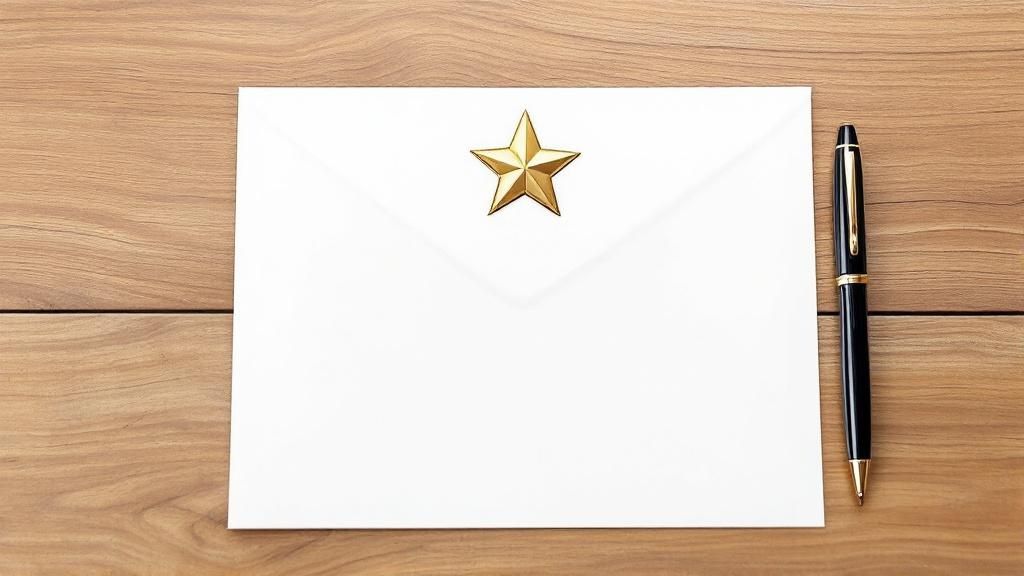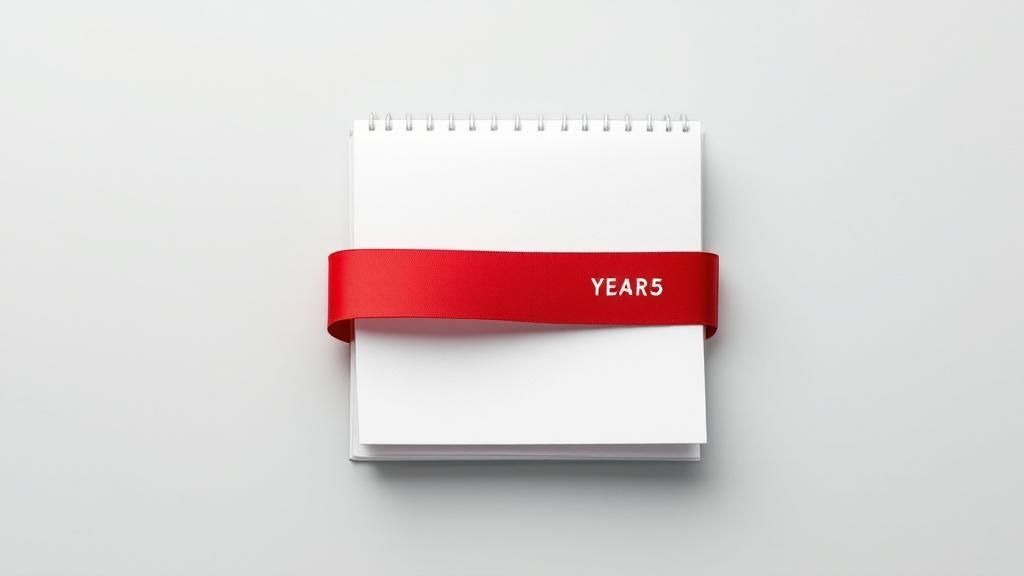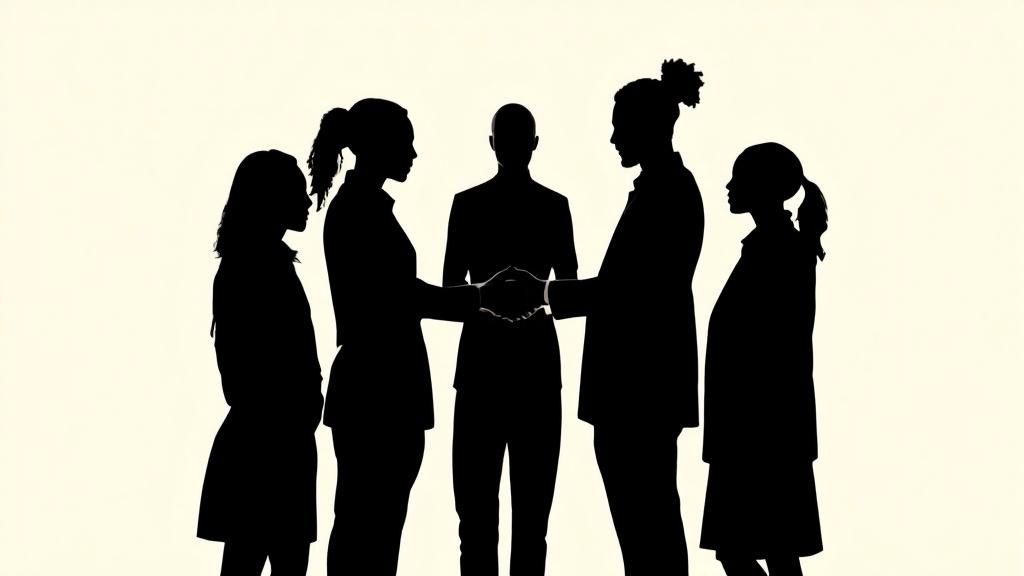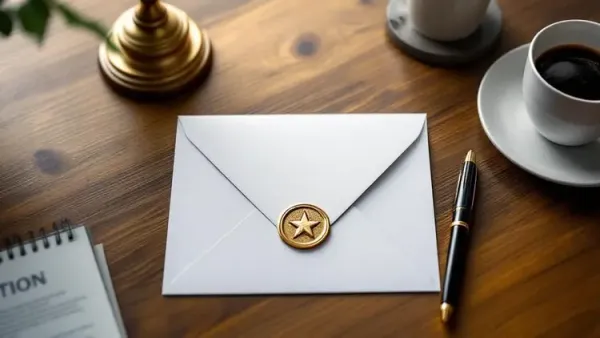The Power of Appreciation: Why Recognition Letters Matter
Want to boost morale and reinforce positive behaviors? This listicle offers seven recognition letter examples to help you effectively appreciate your team. From celebrating employee achievements and years of service to acknowledging outstanding customer service, innovation, and leadership, these recognition letter examples cover key scenarios. Learn how to craft impactful letters that truly resonate, fostering a stronger company culture and driving performance. You'll find examples for team excellence, going above and beyond, and other valuable contributions. Use these recognition letter examples to build a more engaged and motivated workforce.
Quick Summary: When to Send a Recognition Letter
Use a recognition letter to amplify behaviors you want repeated and to make wins visible across the org.
- Occasions: project launch/close, customer praise, stretch goals, values-in-action, service milestones
- Tone: specific, sincere, impact-focused (avoid generic “good job”)
- Timing: within 24–72 hours of the achievement
- Public vs. private: match employee preference; consider posting a short version in a public channel and sending the full letter privately
- Manager tip: close with “what to continue” so the behavior endures
- Peer tip: mention the value demonstrated (e.g., “Customer Obsession”) for cultural reinforcement
Fill-in-the-Blank Template (copy/paste)
Hi [Name],
In [situation/project], you [specific behavior] which led to [impact on team/customer/goal].
This demonstrated our [company value] and moved us closer to [objective].
What to keep doing: [1–2 behaviors].
Optional next step: [opportunity/visibility/ownership].
Thank you for setting the bar for [team/org].
— [Your name/title]
1. Employee Achievement Recognition Letter
An Employee Achievement Recognition Letter is a formal document used to acknowledge and appreciate an employee's exceptional performance, successful completion of a significant project, or outstanding contribution to the organization. This type of recognition letter, often drafted by managers, supervisors, or HR departments, serves as a powerful tool for celebrating specific accomplishments and reinforcing positive behaviors that contribute to the company's success. It’s a concrete way to demonstrate employee appreciation and fosters a positive work environment. This approach offers a personalized and tangible record of an employee’s value, making it a more impactful form of recognition than a verbal compliment alone. It's a key component of a robust employee recognition program and contributes significantly to a positive and productive workplace culture. Recognition letter examples like this demonstrate a commitment to valuing employees.

A well-crafted Employee Achievement Recognition Letter goes beyond simply stating "good job." It provides specific details about the achievement, including measurable outcomes, and connects the accomplishment to the broader company values and goals. This reinforces the importance of the employee's contribution and demonstrates how their individual efforts contribute to the overall success of the organization. The letter should also maintain a professional tone while incorporating a personal touch to make it feel genuine and sincere. Finally, it should include a message of continued support and express expectations for future performance, encouraging ongoing growth and development.
Companies like Google, Microsoft, and Southwest Airlines have successfully integrated recognition letters into their employee appreciation programs. Google's peer-to-peer recognition program, for example, allows employees to send personalized letters acknowledging each other's contributions. Microsoft incorporates recognition letters into its annual achievement awards documentation, highlighting outstanding individual and team performance. Southwest Airlines uses recognition letters as part of its broader employee recognition communications, fostering a culture of appreciation and reinforcing its values. These recognition letter examples illustrate the versatility and effectiveness of this approach across various industries.
Here are some actionable tips for writing effective Employee Achievement Recognition Letters:
- Be specific: Clearly describe the achievement, outlining the specific actions and behaviors that led to the success. Avoid vague statements and focus on concrete examples.
- Quantify the impact: Whenever possible, use quantifiable metrics to demonstrate the tangible impact of the employee's achievement. For example, instead of saying "increased sales," state "increased sales by 15% in Q2."
- Align with company values: Explicitly connect the achievement to the company's core values and strategic objectives. This reinforces the importance of the employee's contribution and demonstrates how their work aligns with the overall organizational goals.
- Be timely: Send the letter promptly after the achievement to maximize its impact and show the employee that their efforts are valued and recognized in a timely manner.
- Personalize the message: While maintaining a professional tone, inject a personal touch to make the letter feel genuine and sincere. Mentioning specific details about the employee's contribution or referencing their individual strengths can enhance the impact of the recognition.
The Employee Achievement Recognition Letter deserves a prominent place in any list of recognition methods due to its versatility and effectiveness. It provides a tangible and personalized form of appreciation that boosts employee morale and motivation. Learn more about Employee Achievement Recognition Letter. By documenting achievements, these letters also create valuable records for performance reviews and provide concrete examples of positive behavior. This can encourage similar performance in other employees and contribute to a culture of excellence. Moreover, recognition letters strengthen the employer-employee relationship, fostering trust and loyalty.
While this approach offers numerous benefits, some potential drawbacks exist. If not implemented consistently, recognition letters can create jealousy among team members who feel their contributions are overlooked. It's crucial to ensure that recognition is distributed fairly and based on merit. Furthermore, crafting personalized letters can be time-consuming, requiring a commitment from managers and HR professionals. However, the positive impact on employee morale, motivation, and performance significantly outweighs these potential drawbacks. Using templates and dedicating specific time for recognition can streamline the process and ensure consistent application. By understanding the benefits and challenges, organizations can effectively leverage Employee Achievement Recognition Letters to create a positive and productive work environment.
2. Years of Service Recognition Letter
A Years of Service Recognition Letter is a formal, commemorative document celebrating an employee's tenure and continued loyalty to an organization. It serves as a tangible expression of gratitude for their long-term commitment and dedication. These letters are often presented during milestone employment anniversaries, such as 5, 10, 15, 20 years, or even longer periods of service. They represent an opportunity to acknowledge the employee's contributions and reinforce the value the organization places on their continued presence. This type of recognition letter example is a powerful tool for strengthening employee relationships and boosting morale.

A well-crafted Years of Service Recognition Letter goes beyond a simple "thank you." It should provide a historical perspective of the employee's journey within the organization, highlighting their growth, significant achievements, and the impact they've made. It also acknowledges the employee's loyalty and dedication, reflecting on how their contributions have aligned with the company’s growth and evolution over time. The letter should conclude with a sincere expression of gratitude for their continued service and a look towards the future.
Examples of successful implementations of Years of Service recognition programs include IBM's long-service award letters for 25+ year employees, often accompanied by gifts and special events. Johnson & Johnson has robust milestone recognition programs that include personalized letters and awards. Even Federal government agencies recognize service anniversaries with formal acknowledgments, highlighting the widespread understanding of tenure's importance.
Why and when to use a Years of Service Recognition Letter:
This approach is particularly valuable when aiming to:
- Reinforce employee loyalty and retention: Recognizing long-term commitment fosters a sense of belonging and appreciation, encouraging employees to stay with the organization.
- Acknowledge stability and institutional knowledge: Long-tenured employees possess a deep understanding of the organization's history, culture, and operations – valuable assets worth acknowledging.
- Create an emotional connection to the organization: A personalized letter can evoke positive emotions, linking the employee's personal journey with the organization's story.
- Demonstrate company values regarding employee appreciation: This shows that the organization genuinely values its employees and their contributions, fostering a positive work environment.
Actionable Tips for Crafting Effective Years of Service Recognition Letters:
- Personalize the content: Avoid generic templates. Include specific memories, anecdotes, or contributions from the employee's tenure. This demonstrates that you value their individual journey.
- Connect individual contributions to organizational growth: Mention how the organization has grown and evolved with the employee's help, highlighting their impact on the overall success.
- Reference specific skills or knowledge they’ve developed: Acknowledge their professional growth and the expertise they've gained throughout their time with the company.
- Include a future vision for their continued contribution: Express excitement about their ongoing role and how they can continue to contribute to the organization's future.
- Present the letter in a meaningful way: Consider presenting the letter in person, during a team meeting or a special ceremony, to amplify its impact.
Pros and Cons of Years of Service Recognition Letters:
Pros:
- Enhances employee morale and engagement.
- Strengthens organizational culture and values.
- Improves employee retention rates.
- Provides a tangible expression of appreciation.
Cons:
- Can seem routine or impersonal if not thoughtfully crafted.
- Might unintentionally highlight salary or promotion stagnation if these aspects haven't progressed alongside tenure.
- Can be less impactful in organizations where tenure isn't highly valued or celebrated within the company culture.
This form of recognition letter has been popularized by traditional corporate HR departments, government agencies with career civil servants, and especially family-owned businesses where loyalty is a cornerstone of their values. In today's dynamic work environment, where employee retention is a significant challenge, Years of Service Recognition Letters provide a powerful, yet often underutilized, tool for recognizing and celebrating the dedication of long-term employees. When executed effectively, these letters are more than just pieces of paper; they are powerful symbols of appreciation that contribute to a positive and thriving organizational culture. They deserve a prominent place in any comprehensive employee recognition program, serving as a tangible reminder of the value and importance of long-term commitment and loyalty.
3. Team Excellence Recognition Letter
A Team Excellence Recognition Letter is a powerful tool for acknowledging and celebrating the collective achievements of a group. Unlike individual recognition, this type of letter focuses on the synergistic efforts of a team, highlighting how their combined skills and collaboration led to outstanding results. It emphasizes the importance of teamwork in achieving organizational goals and reinforces a culture of collaboration. This approach recognizes that success often hinges on the collective effort, rather than solely individual contributions, making it a valuable asset in any organization striving for high performance. This type of recognition deserves its place on this list because it addresses a crucial aspect of organizational success – the power of teamwork.

A Team Excellence Recognition Letter acknowledges the combined efforts of the entire team, celebrating their shared success and the impact it has on the organization. It works by specifically highlighting the collaborative nature of the achievement, mentioning the shared goals, and acknowledging the interplay of individual skills that contributed to the overall outcome. It reinforces the idea that the team's success is greater than the sum of its parts. While recognizing the team as a whole, it also importantly acknowledges individual contributions within the team context. This balanced approach ensures that individuals feel valued for their specific roles while simultaneously reinforcing the importance of the collective effort.
Several successful examples illustrate the effectiveness of Team Excellence Recognition Letters. Apple's product development teams, known for their innovative and collaborative approach, are often recognized through internal letters and awards celebrating the launch of successful products. Similarly, NASA utilizes team achievement letters to acknowledge the complex and collaborative efforts behind successful missions, highlighting the critical roles played by different teams. Procter & Gamble also employs cross-functional team awards, recognizing the contributions of teams from different departments working together to achieve common business objectives. These examples demonstrate how large, successful organizations leverage team recognition to reinforce a culture of collaboration and celebrate shared accomplishments.
When crafting a Team Excellence Recognition Letter, consider these tips:
- Mention specific team members and their unique contributions: While the focus is on the team, acknowledging individual efforts within the team context adds a personal touch and shows appreciation for specific skills and contributions.
- Highlight the challenge overcome and solution achieved: Detailing the obstacles faced and the solutions implemented by the team underscores the complexity of their accomplishment and the value of their collaborative problem-solving.
- Quantify the team's impact on organizational goals: Using metrics and data to demonstrate the tangible impact of the team's work strengthens the recognition and highlights their contribution to the organization's bottom line.
- Distribute copies to all team members and their supervisors: Ensuring wide visibility of the recognition further amplifies its impact and reinforces the value placed on teamwork within the organization.
This approach is particularly effective when a significant milestone has been reached through collaborative effort, such as completing a complex project, exceeding performance targets, or successfully navigating a challenging situation. It's an ideal way to strengthen team cohesion, boost morale, and encourage continued collaboration. Learn more about Team Excellence Recognition Letter and building high-performing teams.
While this type of recognition letter offers many benefits, it's crucial to be aware of potential drawbacks. Individual contributions might be overshadowed by the overall team focus, making it challenging to address all team members equally. Additionally, it might not sufficiently motivate individual high performers who thrive on individual recognition. However, by carefully crafting the letter to acknowledge individual contributions within the team context and combining it with other forms of individual recognition, organizations can mitigate these potential downsides. By understanding the nuances and implementing these tips, you can effectively utilize Team Excellence Recognition Letters as a powerful tool to celebrate collaborative achievements and foster a thriving team-based culture.
4. Customer Service Excellence Recognition Letter
A Customer Service Excellence Recognition Letter is a powerful tool for acknowledging and appreciating employees who consistently go above and beyond in delivering exceptional customer service. This type of recognition letter is typically triggered by positive customer feedback, exceeding customer satisfaction metrics, or demonstrating a strong commitment to the company's customer-centric values. These letters not only celebrate individual achievements but also reinforce the importance of superior service within the organization, ultimately driving a culture of customer obsession. They serve as concrete examples of desired behaviors, demonstrating to all employees what constitutes excellent customer service.

These letters are distinct from general employee appreciation letters because they directly connect employee actions to tangible customer satisfaction outcomes. They showcase how an individual's commitment to service directly impacts the customer experience and, consequently, the business's success. This clear connection between individual effort and business results makes customer service excellence recognition letters a highly effective motivational tool. They highlight the importance of customer-facing roles and the significant contribution these employees make to overall business goals. This type of recognition letter deserves its place in any comprehensive recognition program because it explicitly fosters a customer-first culture.
Key features of an effective Customer Service Excellence Recognition Letter include a direct connection to customer satisfaction metrics (e.g., improved CSAT scores, positive online reviews), specific examples of the employee's exceptional service, alignment with the company's customer service values, and a demonstrable impact on customer relationships (e.g., increased customer retention, positive word-of-mouth referrals). For example, the letter might detail how an employee's proactive problem-solving prevented a customer from churning or how their empathetic approach turned a negative experience into a positive one.
Companies renowned for their exceptional customer service, such as Zappos, Ritz-Carlton, and Amazon, have successfully implemented customer service hero recognition programs and award letters. Zappos' emphasis on empowering employees to "WOW" customers is legendary, with stories of their customer service representatives going to extraordinary lengths to ensure customer satisfaction. Similarly, Ritz-Carlton's legendary service acknowledgments are deeply ingrained in their company culture, empowering employees to create memorable experiences for their guests. Amazon's focus on "customer obsession" is reflected in their award letters, which recognize employees who demonstrate an unwavering commitment to putting the customer first. These examples demonstrate the power of recognition in building a strong customer-centric culture.
While the benefits are numerous, some potential downsides exist. Overemphasis on exceeding customer expectations may create pressure for unsustainable service levels, leading to employee burnout. It could also inadvertently lead to favoritism towards customer-facing roles, potentially demotivating employees in other departments. Finally, consistently measuring and comparing service excellence across different roles with varying customer interaction levels can be challenging.
To craft effective Customer Service Excellence Recognition Letters, consider these actionable tips:
- Include direct customer quotes or feedback: This adds authenticity and emotional impact to the recognition.
- Quantify customer satisfaction improvements: Demonstrate the tangible impact of the employee's actions on metrics like CSAT scores or Net Promoter Score (NPS).
- Connect service excellence to company reputation: Highlight how the employee's actions contribute to the company's overall brand image and customer loyalty.
- Share stories that can inspire others: Use the recognition letter as an opportunity to share compelling narratives that showcase exemplary customer service.
This type of recognition letter is particularly valuable when aiming to reinforce a customer-first culture, provide concrete examples of desired behavior, link employee actions to business outcomes, and motivate continued excellent service. It is ideal for HR professionals, business executives, team managers, employee engagement specialists, and organizations undergoing culture transformations focused on enhancing the customer experience. By implementing a well-structured program of Customer Service Excellence Recognition Letters, organizations can cultivate a workforce dedicated to delivering exceptional customer experiences and achieving sustainable business success.
5. Innovation and Creativity Recognition Letter
Innovation and creativity are the lifeblood of any thriving organization. Recognizing and rewarding these crucial traits is paramount to fostering a culture where employees feel empowered to think outside the box and contribute to organizational growth. This is where the Innovation and Creativity Recognition Letter comes in. It serves as a powerful tool within the broader spectrum of recognition letter examples, specifically designed to celebrate creative thinking, innovative solutions, and process improvements that benefit the company. These letters go beyond a simple "thank you," actively encouraging entrepreneurial thinking and rewarding employees who push boundaries and drive organizational advancement through ingenious problem-solving. This makes it a crucial tool for HR professionals, people leaders, and executives looking to cultivate a dynamic and forward-thinking workforce.
A well-crafted Innovation and Creativity Recognition Letter details the specific innovative solution or idea proposed by the employee. It goes beyond simply stating the idea, diving into the thought process behind it and explaining the methodology used. This demonstrates that the organization values not just the outcome, but the journey of creative problem-solving itself. Crucially, the letter quantifies the impact of the innovation. This could be in terms of increased efficiency, cost savings, new revenue streams generated, or any other measurable benefit to the organization. This tangible demonstration of value reinforces the importance of innovation and provides concrete evidence of the employee's contribution. Finally, a key feature of these letters is the encouragement for continued innovation. By acknowledging the employee’s contribution and expressing excitement for future contributions, the organization fosters a culture of continuous improvement and reinforces the value of creative thinking.
Several prominent examples highlight the successful implementation of innovation recognition. 3M's renowned innovation recognition programs, for instance, have long been a benchmark for encouraging employee ingenuity. Google's '20% time' project acknowledgments, where employees are encouraged to dedicate a portion of their time to personal projects, have famously led to the development of groundbreaking products like Gmail and Adsense. Tesla's celebrations of engineering breakthroughs, often publicized by CEO Elon Musk, further underscore the impact of recognizing and rewarding innovation. These companies understand that fostering a culture of creativity is an investment in their future.
For those looking to implement Innovation and Creativity Recognition Letters in their own organizations, several tips can ensure their effectiveness. First, clearly describe the problem solved by the innovation and the methodology employed. This provides context and showcases the employee's problem-solving skills. Second, quantify the measurable benefits and discuss the potential future impact of the innovation, painting a picture of long-term value creation. Third, acknowledge the risk-taking inherent in innovation, demonstrating that the organization values bold thinking even if it doesn't always lead to immediate success. Finally, encourage the sharing of innovative approaches with others, fostering a collaborative environment where ideas can be cross-pollinated and further developed.
While the benefits are numerous, it's important to acknowledge the potential drawbacks. Overemphasis on innovation may inadvertently pressure employees to constantly innovate, potentially leading to burnout or a focus on quantity over quality. Additionally, evaluating creative contributions can be subjective, making it challenging to ensure fair and equitable recognition. Finally, an excessive focus on innovation could undervalue the contributions of employees who excel in steady, reliable performance, even if they aren't constantly generating groundbreaking ideas.
Despite these potential challenges, the Innovation and Creativity Recognition Letter remains a powerful tool for organizations striving to cultivate a culture of innovation. It not only rewards individual contributions but also signals to the entire workforce that creative thinking and problem-solving are highly valued. This type of recognition attracts and retains creative talent, differentiates an organization in a competitive landscape, and fuels continuous improvement and growth. By understanding the key features, best practices, and potential pitfalls, organizations can effectively leverage this recognition method to unlock the full innovative potential of their employees.
Learn more about Innovation and Creativity Recognition Letter
This specific type of recognition letter deserves its place on this list of "recognition letter examples" because it addresses a critical aspect of modern organizational success: the ability to innovate and adapt. In a rapidly changing business environment, companies that prioritize and reward creativity are best positioned to thrive. The Innovation and Creativity Recognition Letter is a tangible expression of this prioritization, serving as a powerful motivator and a key component of a robust employee recognition program.
6. Leadership Excellence Recognition Letter
A Leadership Excellence Recognition Letter is a powerful tool for acknowledging and celebrating exceptional leadership within an organization. It goes beyond a simple "thank you" and serves as a formal acknowledgment of an individual's ability to inspire, motivate, and effectively guide their team towards achieving goals. This type of recognition letter examples focuses specifically on highlighting leadership qualities, mentoring capabilities, and successful team management, making it a crucial element in any comprehensive recognition program. These letters are designed to recognize individuals who not only drive results but also embody the core leadership values of the organization. This makes them invaluable for HR professionals, People Leaders, Business Executives and CEOs, Team Managers and Department Heads, Employee Engagement Specialists, and Organizations Focused on Culture Transformation.
A well-crafted Leadership Excellence Recognition Letter should showcase specific instances of leadership behaviors and their positive outcomes. It should detail the impact of the individual's leadership on team performance and development, providing quantifiable results whenever possible. This might include improved team productivity, increased employee engagement, successful project completion, or innovative problem-solving. The letter should also connect the demonstrated leadership behaviors to the company's core leadership competencies, highlighting how the individual exemplifies the desired leadership traits. Furthermore, it should acknowledge any mentoring and coaching contributions, emphasizing the individual's role in developing future leaders within the organization.
For instance, a letter might highlight how a manager successfully navigated a challenging project by fostering collaboration and open communication within their team, resulting in on-time delivery and exceeding client expectations. It could also mention their dedication to mentoring junior team members, leading to their enhanced skill development and increased contributions to the team.
Several prominent organizations utilize leadership recognition as a key component of their talent management strategies. General Electric's leadership development recognitions are well-known for their focus on identifying and nurturing high-potential leaders. McKinsey & Company's partner recognition letters exemplify how acknowledging leadership contributions can foster a culture of excellence. Even Military leadership commendations and awards demonstrate the importance of formally recognizing leadership in achieving strategic objectives. These examples underscore the wide applicability and impact of leadership recognition across diverse sectors.
Pros of using Leadership Excellence Recognition Letters:
- Reinforces desired leadership behaviors: By explicitly recognizing specific leadership actions, organizations communicate the values and behaviors they expect from their leaders.
- Identifies and develops future leaders: These letters can serve as a powerful tool for identifying individuals with high leadership potential and providing them with the visibility and encouragement they need to progress in their careers.
- Improves overall management quality: Recognizing and rewarding effective leadership encourages others to emulate those behaviors, ultimately leading to improved management quality across the organization.
- Creates leadership development momentum: By celebrating leadership successes, organizations create a positive feedback loop that encourages continuous leadership development and growth.
Cons of using Leadership Excellence Recognition Letters:
- May create hierarchy or status issues: If not managed carefully, recognizing some individuals for leadership can inadvertently create a sense of hierarchy or exclusivity, potentially demotivating those not recognized.
- Difficult to measure leadership impact objectively: Quantifying the impact of leadership can be challenging, making it difficult to ensure fair and consistent recognition.
- Could discourage individual contributors: Overemphasis on leadership might inadvertently undervalue the contributions of individual contributors who may not aspire to leadership roles.
Tips for writing effective Leadership Excellence Recognition Letters:
- Provide specific examples of leadership in action: Avoid vague praise. Instead, detail specific instances of leadership behaviors and their positive impact.
- Include feedback from team members or peers: Incorporating perspectives from others adds credibility and provides a more holistic view of the individual's leadership.
- Connect leadership behaviors to business results: Clearly demonstrate how the individual's leadership contributed to tangible business outcomes.
- Encourage continued leadership development: Frame the recognition as a milestone in the individual's leadership journey and encourage ongoing growth and development. Learn more about Leadership Excellence Recognition Letter
Using Leadership Excellence Recognition Letters effectively can significantly contribute to a positive and productive organizational culture. By acknowledging and celebrating exceptional leadership, organizations invest in their future, cultivate a strong leadership pipeline, and inspire others to strive for excellence. These recognition letter examples provide a framework for recognizing and rewarding the leaders who drive success and embody the organization's values. Remember to tailor the letter to the specific individual and context to maximize its impact.
7. Going Above and Beyond Recognition Letter
A Going Above and Beyond Recognition Letter is a powerful tool for acknowledging and appreciating employees who consistently exceed expectations, demonstrate exceptional commitment, and take initiative beyond their defined job responsibilities. These letters celebrate the discretionary effort and voluntary contributions that significantly contribute to organizational success. This type of recognition letter examples focuses on highlighting actions that go beyond the call of duty, showcasing the employee's dedication and positive impact on the company. This approach is particularly relevant in today's dynamic work environment, where adaptability, proactivity, and a strong work ethic are highly valued.
This type of recognition deserves a prominent place in any list of recognition letter examples because it addresses a crucial aspect of employee motivation and engagement: recognizing intrinsic motivation. While standard performance reviews and bonus structures address contractual obligations, a Going Above and Beyond letter acknowledges the inherent drive and commitment that fuels exceptional performance. It's a powerful way to reinforce desired behaviors and foster a culture of excellence.
Features of a Strong Going Above and Beyond Recognition Letter:
- Specific Examples: The letter should clearly detail the specific actions taken by the employee that demonstrate their exceptional effort. Vague praise is less impactful than concrete examples.
- Impact Beyond Normal Job Responsibilities: Highlight how the employee's actions extended beyond their typical duties and contributed to the team or organization's success.
- Demonstration of Company Values in Action: Connect the employee's behavior to the organization's core values. This reinforces the importance of those values and shows how individual actions contribute to the overall culture.
- Recognition of Discretionary Effort and Commitment: Explicitly acknowledge that the employee's contributions were voluntary and driven by their commitment to excellence.
Pros of Utilizing Going Above and Beyond Recognition Letters:
- Encourages Proactive Behavior and Initiative: Recognizing and rewarding proactive behavior encourages others to emulate these positive actions.
- Recognizes Intrinsic Motivation and Commitment: These letters acknowledge the inner drive that motivates exceptional performance, fostering a sense of value and appreciation.
- Creates Positive Role Models for Others: Highlighting exemplary employees sets a high standard and inspires others to strive for excellence.
- Builds Stronger Organizational Culture: A culture of recognition and appreciation strengthens employee engagement and loyalty.
Cons to Consider:
- May Set Unrealistic Expectations for Extra Work: It's crucial to frame these letters in a way that avoids creating a culture of overwork or pressure to constantly go above and beyond. Emphasize that these are exceptional instances, not the norm.
- Could Blur Boundaries of Job Responsibilities: Clear communication is essential to avoid confusion about job expectations. The letter should acknowledge the extra effort while maintaining clarity about the employee's core responsibilities.
- Might Create Resentment if Not Applied Fairly: Transparency and fairness are paramount. Ensure that recognition is distributed equitably and based on genuine merit to avoid resentment among team members.
Examples of Going Above and Beyond Recognition in Action:
- Southwest Airlines: Southwest is known for its culture of celebrating employees who go the extra mile for customers, often sharing these "extra-mile stories" internally and externally. This reinforces their customer-centric values and recognizes exceptional service.
- Starbucks: Starbucks has programs that recognize partners (employees) who are actively involved in their communities, volunteering their time and contributing to positive social impact.
- Healthcare Worker Pandemic Response Acknowledgments: During the COVID-19 pandemic, healthcare organizations implemented numerous initiatives to recognize the extraordinary dedication and sacrifices made by healthcare workers. These recognition efforts highlighted the exceptional commitment and resilience demonstrated during a challenging period.
Tips for Writing Effective Going Above and Beyond Recognition Letters:
- Detail the Specific Situation and Response: Paint a clear picture of the situation and how the employee responded, providing concrete details of their actions.
- Explain Why the Effort Was Above Normal Expectations: Clearly articulate why this particular instance was exceptional and went beyond the typical job requirements.
- Quantify the Positive Impact When Possible: If possible, quantify the positive impact of the employee's actions, such as increased sales, improved customer satisfaction, or cost savings.
- Express Genuine Gratitude for Voluntary Contribution: Convey sincere appreciation for the employee's dedication and willingness to go above and beyond.
Popularized By:
Service-oriented companies like Southwest Airlines, healthcare organizations recognizing dedication, and companies emphasizing values-based culture have popularized this form of recognition letter examples. They understand the powerful impact of acknowledging and appreciating employees who demonstrate exceptional commitment and contribute significantly to organizational success. By using this type of recognition letter, organizations can foster a positive work environment, motivate employees to excel, and cultivate a culture of appreciation and high performance.
Recognition Letter Types Comparison
| Recognition Letter Type | 🔄 Implementation Complexity | 💡 Resource Requirements | 📊 Expected Outcomes | ⚡ Ideal Use Cases | ⭐ Key Advantages |
|---|---|---|---|---|---|
| Employee Achievement Recognition | Moderate – requires personalization | Medium – manager/HR time for details | Increased morale, motivation, and behavior modeling | When specific accomplishments need highlighting | Reinforces positive behaviors, strengthens relationships |
| Years of Service Recognition | Low – often templated but benefits from personalization | Low to Medium – HR-driven | Improved loyalty and retention | Celebrating tenure milestones | Builds emotional connection, acknowledges loyalty |
| Team Excellence Recognition | High – balancing individual/team recognition | Medium to High – involves team coordination | Enhanced team cohesion and collaboration | Recognizing group achievements | Promotes teamwork culture, recognizes collective effort |
| Customer Service Excellence | Moderate – requires customer feedback integration | Medium – collection of service data | Reinforced customer-first culture, improved service quality | Customer-facing roles with measurable feedback | Links behavior to business outcomes, motivates excellence |
| Innovation and Creativity | High – requires evaluation of creative impact | Medium – coordination with innovation leaders | Drives innovation, encourages risk-taking | Rewarding inventive problem-solving and process improvements | Fosters innovative culture, attracts creative talent |
| Leadership Excellence | Moderate to High – needs gathering of behavioral evidence | Medium – input from peers, reports | Leadership development, improved management quality | Acknowledging leadership and mentoring effectiveness | Develops leaders, reinforces leadership competencies |
| Going Above and Beyond | Moderate – specific examples required | Low to Medium – manager input needed | Encourages initiative and discretionary effort | Recognizing extra-role contributions during challenges | Builds proactive culture, creates role models |
FAQs
- Q: Should recognition letters be long or short?
A: Short is fine—be specific about behavior and impact; save detail for attached context if needed. - Q: Public or private?
A: Ask preferences. Public builds visibility; private fits sensitive wins. - Q: Can peers send recognition?
A: Yes—peer recognition strengthens culture and reduces manager-only bottlenecks. - Q: What makes recognition feel authentic?
A: Timeliness, specifics, and linking to values and outcomes.
Beyond the Letter: Making Recognition Last
This article provided recognition letter examples for various scenarios, from celebrating employee achievements and years of service to acknowledging team excellence, customer service, innovation, leadership, and above-and-beyond contributions. Mastering the art of writing effective recognition letters, like the examples provided, is crucial for fostering a positive and productive work environment. Remember, a well-crafted recognition letter not only acknowledges individual and team accomplishments but also reinforces desired behaviors and strengthens your company culture.
The most important takeaway is that these recognition letter examples are most impactful within a holistic culture of appreciation. While a formal letter provides a tangible record of achievement, combining it with regular verbal praise, peer-to-peer recognition, and opportunities for professional development amplifies its effect. This multifaceted approach creates a sense of genuine appreciation, boosting morale and motivating employees to excel. By prioritizing recognition, you invest in a more engaged workforce, driving higher performance and fostering a sense of belonging.
Ultimately, recognition is about more than just saying "thank you." It's about investing in your people and creating a workplace where everyone feels valued and inspired to contribute their best work.
Ready to take your employee recognition efforts to the next level? Happily.ai provides a platform for real-time recognition and feedback, seamlessly integrating with your existing workflows to help you build a more engaged and thriving team. Explore the power of ongoing appreciation by visiting Happily.ai today.









